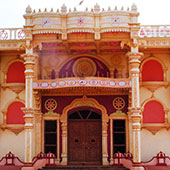Ashtur village near Bidar is the place where the Bahmani tombs are situated, it is around 4 Km away from Bidar City.
Ahmed Shah Wali Bahmani Tomb:
Ahmed Shah Bahamani was a religious ruler. Though worked under the order of Shah Nimat-Ullah, he was greatly devoted to Khwaja Bande Nawaz of Gulbarga. It is believed that this saint added the title “Wali” to his name Ahmed Shah. Ahmad Shah Wali, being the ninth Bahmani Sultan died in 1436 and his son Allauddin built this Majestic tomb for his father.
Allauddin Ahmad Shah II (1436-1458):
Allauddin Ahmad Shah II was a Bahmani king, known for his civilized way of living. After his father’s death, Allauddin took to build a hospital, garden, and a palace along with a tomb in his memory. His rule encountered a number of rebellions, though most successfully handled, they had to eventually surrender to a crushing loss in Konkan. He died during this battle succumbing to grave wounds. It was during the time of Allauddin that Mahmud Gawan entered the service of Bahmani Sultanate. Allauddin Ahmad Shah’s tomb bears a lot of decorations and carvings on its exterior walls. Also, the wide arches are decorated with patterns of black stones.
Humayun Shah (1458-1461):
Humayun Shah was the son of Allauddin Ahmad Shah. During his tenure, he came to be known as Zalim Shah, a nickname bestowed by the Kingdom for his cruel streaks. Owing to his deteriorating health, family members and nobles moved to remove him from the position. But by then he had named his eight-year-old son Nizam Shah as his successor. He made sure that the kingdom affairs were managed by Khwaja Mahmud Gawan, Khwaja Jahan Turk and the Queen mother, under the King’s advice. Zalim aka Humayun could only rule the kingdom for three years and died young at the age of twenty-one years due to an accidental fall. According to history, Humayun Shah’s tomb was struck by lightning and most of its dome and two walls were destroyed. The crushed tomb is a strange sight now.
Nizam Shah (1461-1463):
Nizam Shah's rule was eventful. As he started his rule as a kid, Queen Mother took the major responsibilities under her shoulder. She appointed Khwaja Mahmud Gawan as the prime Minister and Khwaja Jahan Turk as the controller of the state. Sensing the uncertainties at Bidar, the neighboring Kingdoms pressed forward to attack. Thus, Mahmud Khalji of Malwa captured Bidar city and arranged a barrier to the fort. Lately, at the request of Mahmud Gawan, the prime minister, Mahmud Shah of Gujarat came to help which forced Mahmud Khalji to retreat. Nizam Shah suddenly died in 1463 when preparations for his marriage were on. His tomb was built by Malika-i-Jahan, keeping it next to Humayun’s Tomb. The tomb curiously remained incomplete and is open with the dome missing. The strongly built walls suggest that they were designed to hold a big dome.
Mohammed Shah III Lashkari (1463-1482):
Mohammed Shah III Lashkari came as the successor to the Nizam Shah reign. He was the brother of Nizam Shah and another nine years old. Even during his tenure, the Council of Regency had to handle the governing affairs. The prince grew into a learned king and his first takeover was the fort of Kherla in Malwa. With this, the kingdom stretched from Goa to Rajahmundry in Andhra Pradesh and Kanjeevaram in the south. By the time, Nobles realized that Mahmud Gawan had grown strong and popular, posing a threat to the King’s stature. Hence they decided to immediately forge a letter with Mahmud’s signature and made the drunken King pass orders to kill Mahmud Gawan. Later the king, realizing his mistake drank himself to death. Mohammed shah III was buried next to his brother Nizam Shah. Mysteriously, even his tomb was found incomplete.
Mohammed Shah IV (1482-1518):
Mohammed shah IV again a boy of twelve years succeeded his father. Though he ruled for a long time compared to predecessors, by then Bahmani Sultanate had already been divided into independent kingdoms of Ahmednagar, Berar, and Bijapur, as an aftermath of several rebellious outbreaks. Hence Bahmanis was no longer a dynasty. Mohammed Shah IV built his own tomb along with several additions to the Bidar Fort. The tomb is unique with majestic arches on the walls. Mohammed Shah IV’s nominal successors were his sons Ahmad Vira Shah III (1518-1521), Alauddin Shah III (1521-1522). Even their tombs can be found in the Bidar Fort complex, exalted with conical domes and arches.






















